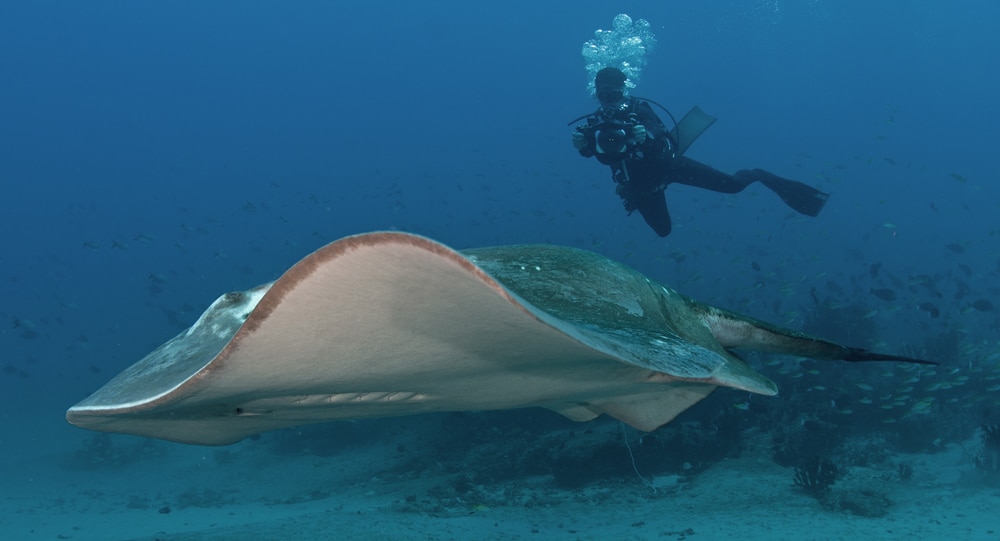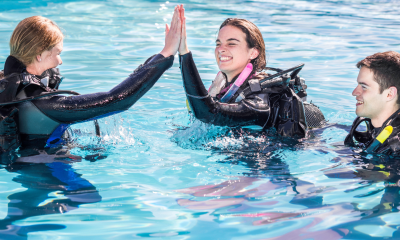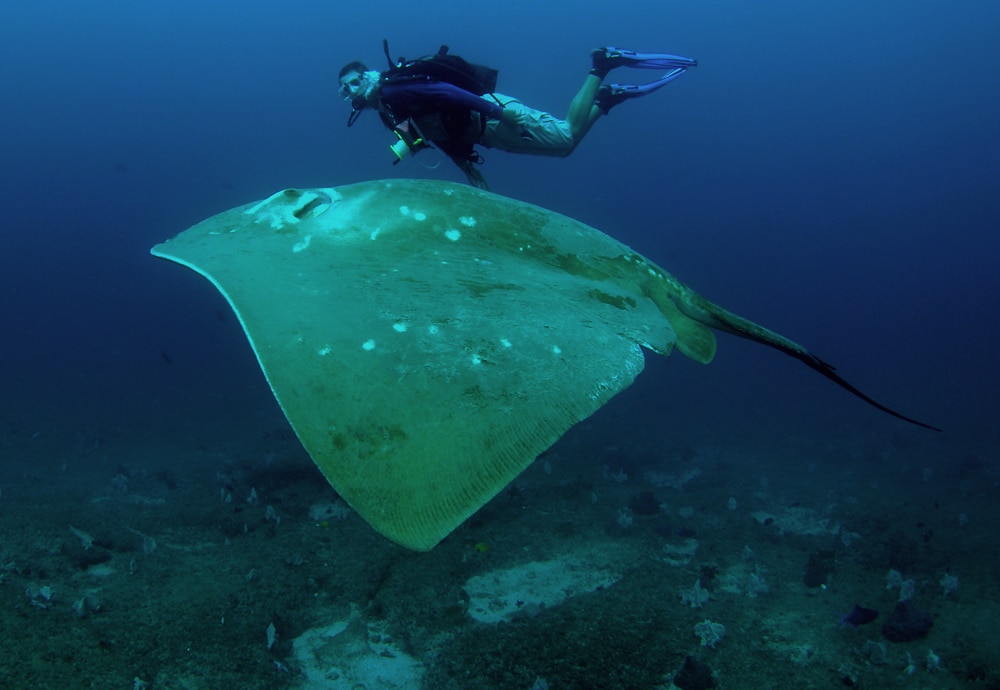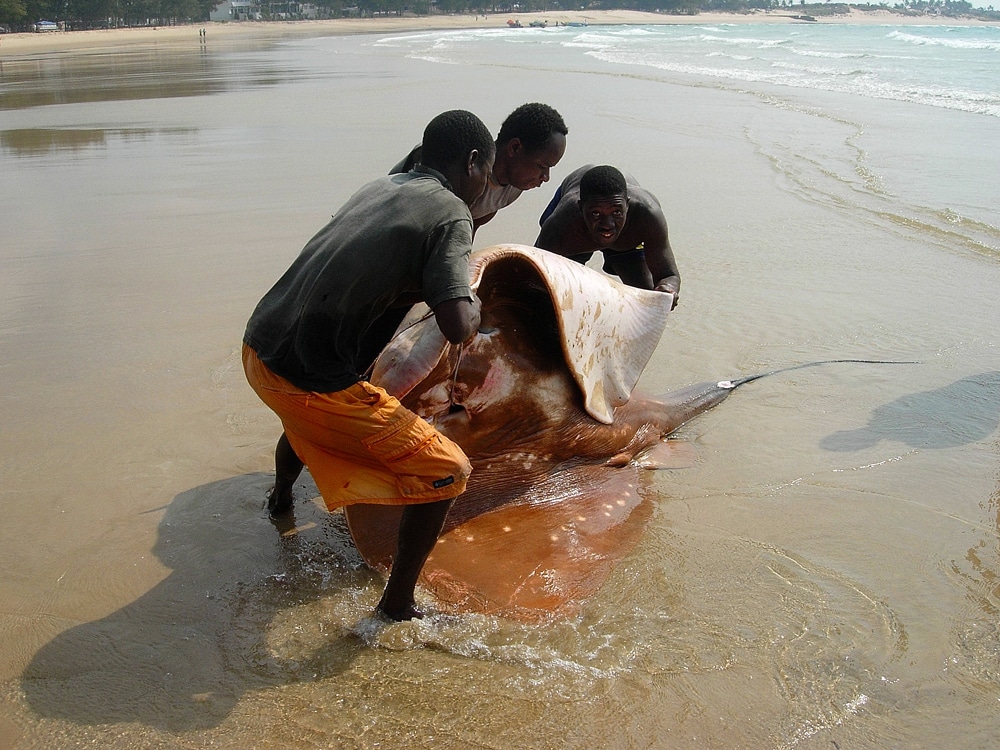News
First study of world’s largest marine stingray reveals long-distance migration

 Scientists use images and videos submitted by tourists to track rare species in Africa
Scientists use images and videos submitted by tourists to track rare species in Africa
Smalleye stingrays are the largest marine stingrays on record, reaching disc widths of up to 222 cm, and yet almost nothing is known about them. Scientists from the Marine Megafauna Foundation have for the first time used photo IDs to study this elusive animal in southern Mozambique, one of the only locations where it is regularly seen in the wild. Their findings were published in the journal PeerJ.
“We reported the first sightings of smalleye stingray in 2004 and have since been racing against the clock to learn more about their ecology before it is too late”, said Dr Andrea Marshall, co-founder and principal scientist of the Marine Megafauna Foundation. 31 percent of the world’s sharks and rays are threatened with extinction according to the IUCN Red List of Threatened Species ‒ due to lack of scientific effort and information, it has not been possible to evaluable the conservation status of smalleye stingrays to date. “This species of ray is likely in trouble too but we can’t protect what we don’t know much about. Our study is an important first step in understanding more about the animal’s ecology and behaviour“, she added.
“These mysterious giants are thought to be patchily distributed across the Indian Ocean and Western Pacific, but southern Mozambique is probably the best location to encounter them on inshore reefs”, Marshall added.
The marine biologists tested whether photographs of the stingrays’ (Megatrygon microps) white dorsal spots could be used to distinguish and track individuals over long periods.
“Through local dive centers, we called on tourists to help us collect images of this solitary stingray. Fortunately for us, southern Mozambique and its rich marine life attract many passionate scuba divers, most of which own GoPros or other lightweight cameras and will happily make their images and footage available for research”, said Atlantine Boggio-Pasqua who volunteered with the Tofo-based foundation.
She added: “Their contributions proved immensely valuable, we managed to gather more than 140 photographs suitable for comparison and identification, with some images dating as far back as 2003.”
The team was able to visually identify 70 different individuals, including 15 that had been seen on several occasions in the area. The dorsal spot patterns looked unchanged over the years indicating they may be permanent markings like in manta rays.
Boggio-Pasqua said: “Smalleye stingrays may look intimidating at first glance with their large, razor-sharp tail spines, but they’re actually really charismatic and easy to approach. We hope to receive many photo and video contributions from citizen scientists in future. They could tell us more about the species’ habitat preference as well as feeding and cleaning behavior.”
The encountered stingrays were often spotted at cleaning stations where reef bannerfish and other small fish appeared to be removing parasites from the rays’ skin.
The photographic study also provided a glimpse into the migratory behaviour of Megatrygon microps. Some individuals traveled hundreds of kilometers along the coastline, including a near-term pregnant female which traveled from Tofo to the Bazaruto Archipelago and back (200km in a minimum of 102 days and a total 400km return trip). She returned to Tofo, no longer visibly pregnant, suggesting this individual had pupped during her journey.
This proved to be the longest straight-line distance ever recorded for any species of whiptail stingrays (Dasyatidae family). Unlike other stingrays, smalleye stingrays are rarely seen resting on the seabed and are thought to be semi-pelagic.
Smalleye stingrays are likely under threat from increasing fishing pressures. Targeted and incidental catch in coastal gillnets and industrial purse seiners operating offshore are an ongoing issue in Mozambique.
“There are so many questions that remain unanswered about this rare species. Where do they live, how fast do they mature and how do they reproduce? Filling these knowledge gaps is crucial to figuring out how to protect them properly in Mozambique and other parts of the Indian Ocean”, concluded Dr Marshall.
Addressing the lack of available data will eventually allow scientists to formally assess the species’ conservation status in the IUCN Red List and inform management practices.
The study by Atlantine Boggio-Pasqua, Anna Flam and Andrea Marshall, titled ‘Spotting the “small eyes”: using photo-ID methodology to study a wild population of smalleye stingrays (Megatrygon microps) in southern Mozambique’ is published in the journal PeerJ on 11 June 2019 and is freely available here.
For more information about the work of the Marine Megafauna Foundation visit their website by clicking here.
News
Book Review: Fire on Monroe Bravo by Fred Lockwood

Fire on Monroe Bravo is the latest book in the Jack Collier series by Fred Lockwood. Our story begins with our lead characters, Jack and Sandro, owners of Marine Salvage & Investigation Company, arriving on the Monroe Bravo Oil & Gas Platform in the North Sea. Having secured a contract for their vessel the MV Stavanger to act as support ship to the platform for TransGlobal Oil, our protagonists are on a celebratory visit.
However almost as soon as they arrive a series of explosions rock the platform, causing huge damage, loss of life and the very real danger of a massive human, ecological and financial disaster.

As the danger mounts for both our heroes and the surviving workers, Jack and Sandro will have to escape the inferno, all while trying to save the platform and the men still trapped unable to help themselves.
The disaster sets the scene for the unfolding story lines following the fate of the platform and our main characters, the police investigation into a suspected terrorist act and the actions of TransGlobal Oil as they attempt to navigate the pubic outcry and financial repercussions.
In his eighth book, Fire on Monroe Bravo, Fred Lockwood delivers an explosive thriller, with plenty of above and in-water drama, and our heroes fighting for survival, what more can you ask for?
We thoroughly recommend this read and look forward to the next in the series. For more information about his book series, you can check out the reviews of his previous books here on Scubaverse.
- Title: Fire On Monroe Bravo
- Author: Fred Lockwood
- ISBN: 979-8325324536
Available in a paperback version and for Kindle from Amazon and book stores.
Blogs
Alonissos: The complete diving destination (Part 1)

In June we were incredibly fortunate to be invited to dive in Alonissos, a small Greek Island in the Sporades island chain located in the North Aegean Sea. While I have long been a big fan of the Greek Islands as a great holiday destination, I had not had the opportunity to do any diving on previous visits and Mike and I were extremely excited to see what Alonissos had to offer both above and below the surface!

The Sporades are easily accessible via the airport in Skiathos (the first island in the chain), which is served by Jet2 flights from all major UK airports from May through October. Numerous ferries and charter boats make island hopping from Skiathos Town a breeze. After an hour boat ride, the picturesque port of Patitiri was a wonderful introduction to Alonissos, where we were met by our gracious hosts Kostas of Albedo Travel and Dias of Alonissos Triton Dive Center. Mike and I were delighted to be staying at the Paradise Hotel, aptly named for its stunning views over the sea and great location for walking to the waterfront.

Alonissos is beautifully situated in the National Marine Park of Alonissos and the Northern Sporades, the largest marine protected area in Europe. The surrounding seas offer fabulous marine life, including incredibly rare species such as the Mediterranean monk seal. They boast deep walls covered in gorgonians and sponges, stunning topography with caverns, swimthroughs and pinnacles, and the first accessible ancient shipwreck from 500BC!

In locations where historical sites have been reported, the waters are largely restricted, but with collaboration between government, underwater archeologists and dive centres, incredible underwater museums are being created for a truly unique diving experience. Alonissos is home to the first of these, the Ancient Shipwreck of Peristera Accessible Underwater Archeological Site. The chance to dive into history (along with reports of healthy reef life and amazing underwater topography) meant Mike and I were keen to get in the water.

Our introduction to the diving around Alonissos was at the Agios Georgios Pinnacles, in the channel between Alonissos and Skopelos. This fantastic site was named “The Chimney,’ and proved to have a huge amount to see. We got to a decent depth here (over 25m), and marvelled at a colourful reef wall with a wonderful swim through whose rocky walls were absolutely covered with life. As well as brilliant topography there was no shortage of macro life here. We saw numerous nudibranchs, five different species in total. The second dive at Mourtias reef nearby was a shallower dive along a nice wall with lots of crevices. Several moray eels and grouper called this site home. We enjoyed looking in the crevices for lobster and smaller benthic life, such as cup corals and tunicates.

Our itinerary allowed us two dives a day with afternoons left to explore the island with our hire car and evenings to enjoy the famous Greek hospitality. This proved to be a lovely mix of in-water and land based diversions.

The next days diving to the Gorgonian Gardens and Triton’s Cave was to be even better! These two stunning sites are nothing short of fabulous. The Gorgonian Gardens was a deep wall near to the Agios Georgios islands. The ever-present currents in this deep channel meant that the sea life was amazing … the namesake Gorgonian sea fans dotted the wall at a depth of 30 to 50 meters, getting ever larger the deeper we went. Above 30m was by no means less beautiful, with sponges, corals, scorpionfish, moray eels and some rare and colourful nudibranchs.

The second shallower dive of the day was to Triton’s Cave or the Cavern of Skopelos, on the east side of that island. The spectacular rock formations had wild striations both above and below the water making a truly epic topography. The cavern entrance was at 14m, and big enough for a buddy pair, winding up to 6m and passing two beautiful windows out into the blue. Emerging from the cavern, the light at the shallower depths and the incredible rock formations made for a fantastic gentle swimming safety stop and we all surfaced by the boat with massive grins.

Check out our next blog :Alonissos: The complete diving destination (Part 2)” to hear about our amazing dive on the 2500 year old Peristera Wreck!
Thanks to:
Alonissos Triton Dive Center https://bestdivingingreece.com/
Albedo Travel https://alonissosholidays.com/activities/
Paradise Hotel https://paradise-hotel.gr/
Alonissos Municipality https://alonissos.gr/en/
-

 Blogs2 months ago
Blogs2 months agoDiving With… Nico, Ocean Earth Travels, Indonesia
-

 News1 month ago
News1 month agoMurex Bangka Announce New Oceanfront Cottages & Beachfront Dining
-

 Blogs2 months ago
Blogs2 months agoA new idea in freediving from RAID
-

 Marine Life & Conservation1 month ago
Marine Life & Conservation1 month agoIceland issue millionaire whale hunter a licence to murder 128 vulnerable fin whales
-

 Marine Life & Conservation2 months ago
Marine Life & Conservation2 months agoThe Shark Trust Great Shark Snapshot is back
-

 News3 months ago
News3 months agoCharting New Waters; NovoScuba Goes Global with the Launch of their Revolutionary Dive Training Agency!
-

 Gear News1 month ago
Gear News1 month agoNew Suunto Ocean – a dive computer and GPS sports watch in one for adventures below and above the surface
-

 Marine Life & Conservation Blogs2 months ago
Marine Life & Conservation Blogs2 months agoBook Review: Plankton















